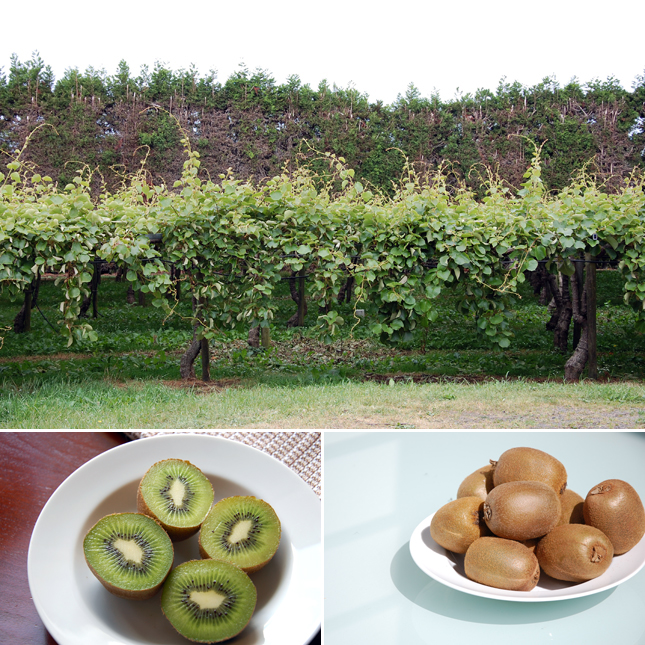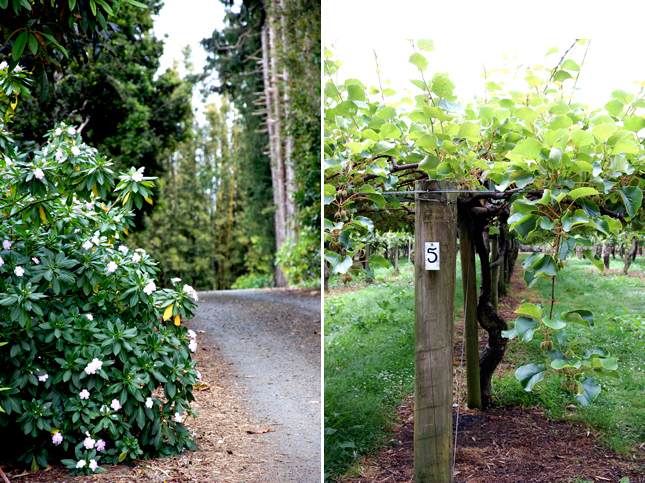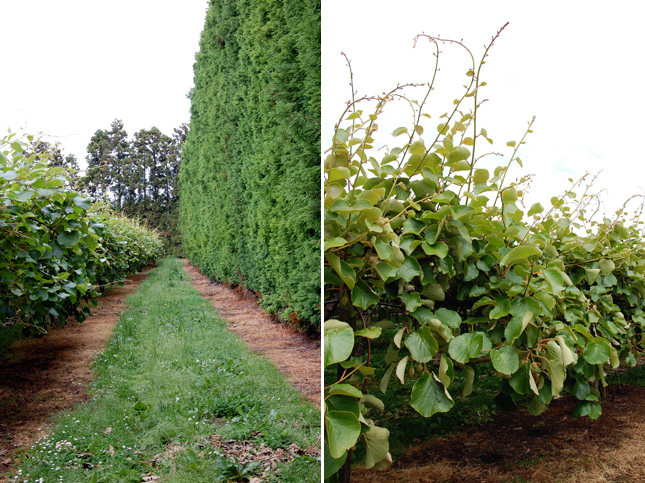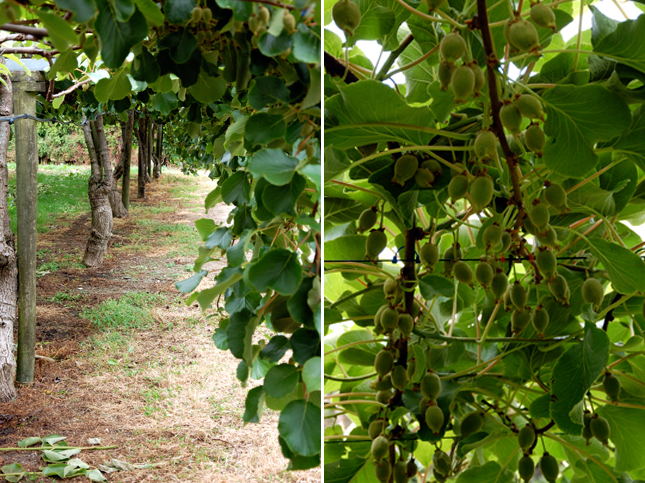
In New Zealand there are three kinds of kiwis. First, there are Kiwis, the people of New Zealand identifiable in print by the use of the upper case K. Second is the fuzzy, endangered, flightless bird. Third, the fuzzy, not at all endangered, flightless fruit.
Linguistically, the use of the word kiwi for the fruit is the youngest though the fruit itself is ancient. Chinese in origin, the Yang-tao or Pinyin (literal translation: “strange fruit”) grows wild and is cultivated in the Zhejiang Province in forests and orchards along the Yangtze River. In China the fruit tends to be larger and less uniformly shaped than the cultivar most of us know, the Hayward.
The fruit arrived in New Zealand in the early part of the 1900s. Seeds were brought by the headmistress of the Wanganui Girl’s College, Mary Isabel Fraser who was said to have enjoyed many a kiwifruit when visiting schools in China. Some of those seeds arrived in the hands of local farmer Alexander Allison who brought in the first crop in 1910.
For a long time there were only a few Chinese gooseberry growers in New Zealand and it took until the 1940s for the fruit to gain a large enough fan-base to warrant large scale planting. In 1952 the first sizable shipment of kiwis left New Zealand for England. By the middle ‘50s demand for exotic fruits had increased enough that the Americans decided to get in on the action and kiwi orchards were planted in California. Again the Chinese gooseberry changed names and was briefly known as the melonette. In 1959 melonette growers were forced to tackle an unusual semantic problem. Melons and berries were subject to higher import trade tariffs worldwide and though their product was neither melon or berry their ‘strange fruit’ was thought to be both by customs officials. To be rid of the confusion and avoid the excess charges producers had to come up with a new name. In a fit of “Shaky Island” inspiration kiwi plantation owner Jack Turner threw out the Maori word kiwi (as in the indigenous bird) at a growers conference held in Auckland and the name stuck.

Kiwi plants are deciduous trees that require the specific kinds of growing and climactic conditions that occur naturally in New Zealand. Though they are hearty enough to endure frosts and need mild winters to go dormant, extreme drops in temperature will do the plants in. To bear ripe fruit they need at least 240 days of moderate sunshine, a lot of moisture and soils with a high pH. (pH levels between 5 and 6.8 are ideal.) High pH soils are oftentimes volcanic. In the case of New Zealand, a nation that, geologically speaking, rests on some of the world’s more juvenile dirt, the land is made of volcanic soils 4,000 to 40,000 years old. Some of the largest of these deposits are found on the North Island around the Bay of Plenty where about 80% of New Zealand’s total kiwi crop is grown.
Despite the nation’s push to be perceived as the kiwi capitol of the world they are not. The title of biggest kiwi grower goes to Italy where 26% of the world’s kiwis come from, followed by China (25%), then New Zealand (21%). A peculiarity of the kiwi market is that the Italians sell the majority of their product in China, the Chinese sell most of their kiwis in northern Europe and the majority New Zealand kiwis go to Japan, Spain and the Netherlands. (Around 7% of New Zealand kiwis exported go to Italy!) Some kiwis will travel on average 11,242 km / 6,986 mi from their country of origin.
Though New Zealand isn’t the largest producer there are practices that set the Kiwi kiwi industry apart. The main one being that New Zealand growers are banded together under a unified marketing organization/partnership that is 100% grower owned called Zespri. The organization has been around in one form or another since kiwis were planted in 1904. Today there are 3,077 orchards registered to 2,754 Zespri growers in New Zealand. The organization represents another 2,000 growers outside of the country. Gerry Piper, who raises Golden Kiwifruit in Kerikeri, is a stakeholder in Zespri. He explained that, “Because of Zespri, New Zealand produces much better quality kiwis, and unlike any other item of produce sold anywhere in the world, the fruit is guaranteed by Zespri.” To do this, “Every piece of Zespri kiwifruit sold globally can be identified and tracked back according to grower and packing house origin.” Another difference is the quality control system in which every kiwi is hand-selected at packing houses around the country before being exported. (Annually 10% to 12% of the fruit harvested is damaged or deemed inferior and is sold to juice manufacturers and the livestock industry.)

In New Zealand, Zespri and the kiwifruit growers have a lot of clout. Kiwifruit is a NZ$3 billion / US$2.2 billion a year business. Zespri alone posted a NZ$1.45 billion / US$1.07 billion profit. The continued success of the kiwifruit is seemingly so important to Zespri, and all New Zealanders, that the organization recently went out of pocket NZ$20.5 million / US$15.2 million to front the research for new cultivars to match the success of Zespri’s somewhat new Gold Kiwifruit hybrid. The remaining money will come from taxpayers—most of whom seem keen to have public funds spent on the fruit. The funding is expected to shrink the research and development time down from the usual twenty-five years to just ten.
The goal of the project is to produce new kinds of kiwis; ones that will boost earnings the way the gold kiwi (a.k.a. Gold Kiwifruit or Hort16A) has since it hit the market in 1998. The gold kiwi is just that, gold, not green, on the inside. It originated in China then was bred to gold in a lab in Te Puke, New Zealand. The gold is sweeter and less acidic than the green as well as being noticeably less hairy. (We found the flavor to be quite honeyed.) The gold variety also nets greater yields, about 12,000 trays per ha / 2.47 ac while green will average 7,000 trays per ha.
Some of the stated ideas for new kiwis sound a little wacky or just plain eerie. One thought is to create kiwis that come in new colors. Orange and bright yellow are in the works and a red kiwi has hit some markets already. Another plan is to tailor certain kinds of flavors to specific markets. For example, the Asian market tends to like sweeter kiwis so a sweeter version would be crafted to fit that niche. The so-called “holy grail” for some kiwi researchers is to develop a fruit that produces a “taste explosion” with either an edible skin or one that peels as easily as a banana.
Whether the consumer is ready for, or even wants a red kiwi, doesn't seem to have deterred the New Zealand kiwifruit industry from charging headlong into the task of transforming the humble, green kiwi into a multicolored fruit bauble. The scientist at Zespri and other research labs working on new kiwis have vowed to not genetically modify the kiwi. The plan is to refashion it using traditional plant breeding techniques. In the end they may find a way to make an already “super food” more super.

More kiwi facts:
A kiwifruit has twice as much vitamin C as an orange, the same levels of potassium as a banana and only half the calories.
Kiwifruit contains the antioxidant compounds vitamins A, C, E, beta-carotene, lutein, and lycopene as well as numerous polyphenols.
Kiwifruit is a natural digestive aid and assists in bowel function.
Studies have shown that kiwis aid in the prevention of asthma by alleviating coughing and wheezing, especially in children.
The skin of the kiwifruit is edible.